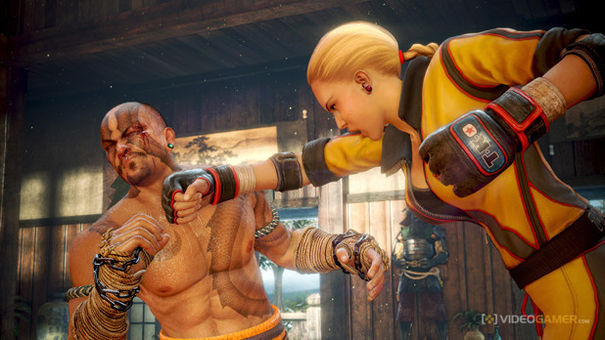



Despite what some may say, there's nothing inherently awful about Kinect. Ubisoft's Fighter Within isn't great, or even approaching passable, and I may have left the room within 15 seconds of starting it to have a big think about the direction of my life. But for all it aims to achieve - which is essentially nothing - it's a game also hamstrung not necessarily by technology, but by us.
Full-body motion control titles are limited by two key factors: the diversity and skill of a player's movement, and the technology's ability to detect fine movement and detail. Kinect 2.0 is improved over its predecessor in regards to the latter, and its advances are typified, if not exactly used very well, by Fighter Within.
Despite what marketing and promotional guff might have you believe, Fighter Within is played facing the camera and television, not your adversary, imaginary or otherwise. For the most part unleashing the paltry four variations of basic punch is straightforward and warmly greeted by Kinect. Not quite with the “unprecedented 1:1 precision movement tracking” the box bellows, but it's a start.
The problem with Fighter Within is us, and the inherent discord between real-life fighting ability and the fighting genre's take on it. The fighters inside us generally aren't highly-trained students of Krav Maga, or even lowly-trained in the art of the Friday night pub car park brawl. We are, for the most part, feeble sacks of offal, after all. I'd rather make punch than throw one, and due to Fighter Within's very real obligation to pander and allow the untrained to have a taste at unleashing The Dragon, the only option is to restrict the more exotic manoeuvres.
This means no jumping, juggling or anything resembling Voldo's sexy crab dance. It results in an exercise of arduous monotony, forcing the equivalent of human button-mashing without considering the finer points.
Once you've mastered the meticulous art of repeatedly flopping your loosely-clenched fist out in front of you, it plummets into a game of rock, paper, safety-scissors. Oddly, repeating the same action is the only means to generate 'combos', and striking the same guard repeatedly spawns an auto-counter. These in turn can be negated with the (rather faffy) grapple, perpetuating an endless cycle of banality.
Manual counters are possible, gratifying in the extreme when executed correctly, but that alone doesn't dispel the sense that this is a colour-by-numbers fighting game where every cell is a shade of brownish yellow.
It's left to the Ki system to introduce variety. It's a chargeable power allowing for heftier moves, such as roundhouse kicks and slams, but falls flat when it yanks on the emergency brake, stopping everything dead. Ki can only be charged when still, veins popping on your forehead as you fail to turn Super Saiyan, often leading to grimacing characters glaring at each other nose-to-nose, entirely uninvolved in combat.

Regular jabs may feel responsive, but every combo, counter or special move outside of them is performed through a limited set of pre-determined animations, distancing the player from action. They're essentially KTEs (Kinect time events): rather than slamming a button input, instead you gesticulate, the fissures between these stealth cutscenes and gameplay lit up by spotlights. Inevitably, there's a glaring disconnect, negating the few nuggets of joy the game offers by largely leaving you twiddling your thumbs on the sidelines.
Technical blunders aside, Fighter Within is still an example of Kinect working relatively well, but also how sparingly it should be used in certain games. Kinect-style motion control has proven time and again that it cannot function in more traditional genres, such as shooters, third-person fighting games, or 'serious' sports.
It has, however, performed admirably in party fare, and tools like Xbox Fitness, acknowledging its participant's limitations through creating practical and enjoyable tasks. Fighter Within has the potential to do this: its jab recognition is canny enough to hold up on its own, just not in this arcade fighting genre. A boxing-only title perhaps, with a wider variety of input recognition, combined with some next-gen facial deformation is an angle with broad potential. But Fighter Within isn't that.
Terrible it may be, yet it's not a nail in the Kinect coffin by any stretch. As well as a much-welcomed rise in responsiveness, at least Kinect 2.0 can function in rooms smaller than Liverpool Cathedral, accommodating even my humble Victorian terrace with its terrifying trio of infrared lights. As a game there are no saving graces, even when air-slapping at a close friend in local multiplayer, but in taking tiny portions and learning from Fighter Within's myriad mistakes, there's life in the new Kinect yet.



